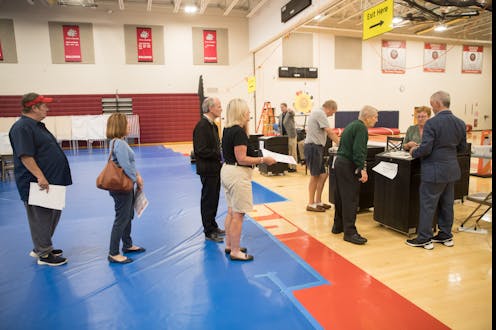Young voters are more likely to skip midterm elections than presidential races
- Written by Jan Leighley, Professor of Government, American University School of Public Affairs

Midterm elections typically have lower voter turnout than presidential elections, but there is another crucial difference beyond just how many people vote: how old they are.
If past turnout patterns hold in 2022’s midterm election, most demographic groups will be represented as much as they are in presidential elections, with one major exception. People ages 18 to 29 represent 16%[1] of the total U.S. population. But they will be a smaller proportion of voters in November.
That’s a key finding of my research with political science collaborators Brian Hamel[2] and Jonathan Nagler[3].
We wondered whether midterm elections are, because of their lower voter turnouts, less representative than presidential elections. For our initial findings, we compared the share of votes cast by different demographic groups in every midterm from 1974 to 2018 and those groups’ vote shares in presidential elections from 1972 through 2016.
During that period, people ages 18 to 29 cast 17% of the ballots in presidential races but just 12.8% of the votes in midterm elections, a drop of 4.2 percentage points. By contrast, the share of voters over the age of 45 rises almost 6 percentage points in midterm election years over their level in presidential elections.
When we analyzed differences in the share of voters by race, income and education levels, we found nearly equal levels of vote shares for these groups in both midterm and presidential elections. Yes, turnout is lower in all these midterms compared with presidential elections. But the representation of different voter groups is about the same – except for age.
Winners matter, but so do voters
This representation difference is important. The winners of a nonpresidential election are determined by who gets the most votes. But research shows that the policies that winning elected officials pursue[4] are determined in part by who voted for them. If younger people are underrepresented in midterm elections, then their policy views will also be underrepresented when winning midterm candidates vote on important issues.
If younger and older citizens supported the same policies, then underrepresentation of younger voters in the vote share wouldn’t matter. But people of different ages often have different views[5] on key issues.
These age-based differences are also evident in policy views. Older Americans tend to report greater opposition to abortion rights[6] and less support for universal government-run health care.
At the most basic level, the age differences involve party affiliation. The Cooperative Election Study[7] is a scholarly national public opinion survey conducted regularly since 2006. In its survey about the 2018 midterm election, younger voters were found to identify significantly more often as Democratic[8] than Republican, while older voters are much more likely to identify with the Republican Party.
So if younger voters are underrepresented in the November 2022 elections, more Republicans may be elected, as well as candidates less likely to reflect younger citizens’ views on key issues.
Overall turnout can mask differences
With crucial issues like inflation, racial and economic equity, climate change and abortion rights all factors in the campaign, and a large number of competitive districts, some pundits are projecting that overall turnout may even surpass 2018’s record of 50.1%[9] of eligible voters.
But even if that happens, record high turnout does not guarantee that younger voters will be better represented. In 2018, for instance, younger voters turned out in larger numbers but were still underrepresented[10] because other age groups also turned out in larger numbers.
It’s possible that 2022 could be different. It is true that more younger people report being politically involved[11] now than in years past. But they also are less likely to have voted previously and may need to deal with legal and bureaucratic registration requirements[12] that older voters have already handled.
As in many previous midterm elections, efforts to mobilize young voters are underway, including initiatives on college campuses and a broader network of nonpartisan organizations[13] actively mobilizing younger citizens’ turnout. That may help younger voters understand their potential power, although in past elections it hasn’t led young voters to turn out in enough numbers to narrow the gap with older voters’ turnout.
A newer type of mobilization activity[14] that might – whether intentionally or otherwise – target young people more than established voters is increasing social media outreach by election administrators’[15] providing details on the local voting requirements.
Perhaps this newer mix of mobilization approaches, along with high salience of issues of special importance to younger citizens, may help them to overcome the steeper costs they must bear to have their voices heard – and to have more of their votes counted.
References
- ^ ages 18 to 29 represent 16% (www.census.gov)
- ^ Brian Hamel (www.brianhamel.me)
- ^ Jonathan Nagler (as.nyu.edu)
- ^ policies that winning elected officials pursue (doi.org)
- ^ different ages often have different views (www.pewresearch.org)
- ^ greater opposition to abortion rights (doi.org)
- ^ Cooperative Election Study (cces.gov.harvard.edu)
- ^ significantly more often as Democratic (doi.org)
- ^ may even surpass 2018’s record of 50.1% (rollcall.com)
- ^ were still underrepresented (www.washingtonpost.com)
- ^ more younger people report being politically involved (iop.harvard.edu)
- ^ legal and bureaucratic registration requirements (www.thirdway.org)
- ^ broader network of nonpartisan organizations (www.studentvoteresearchnetwork.org)
- ^ newer type of mobilization activity (theconversation.com)
- ^ social media outreach by election administrators’ (www.washingtonpost.com)
Authors: Jan Leighley, Professor of Government, American University School of Public Affairs


